Artwork(s) In Focus, Art History
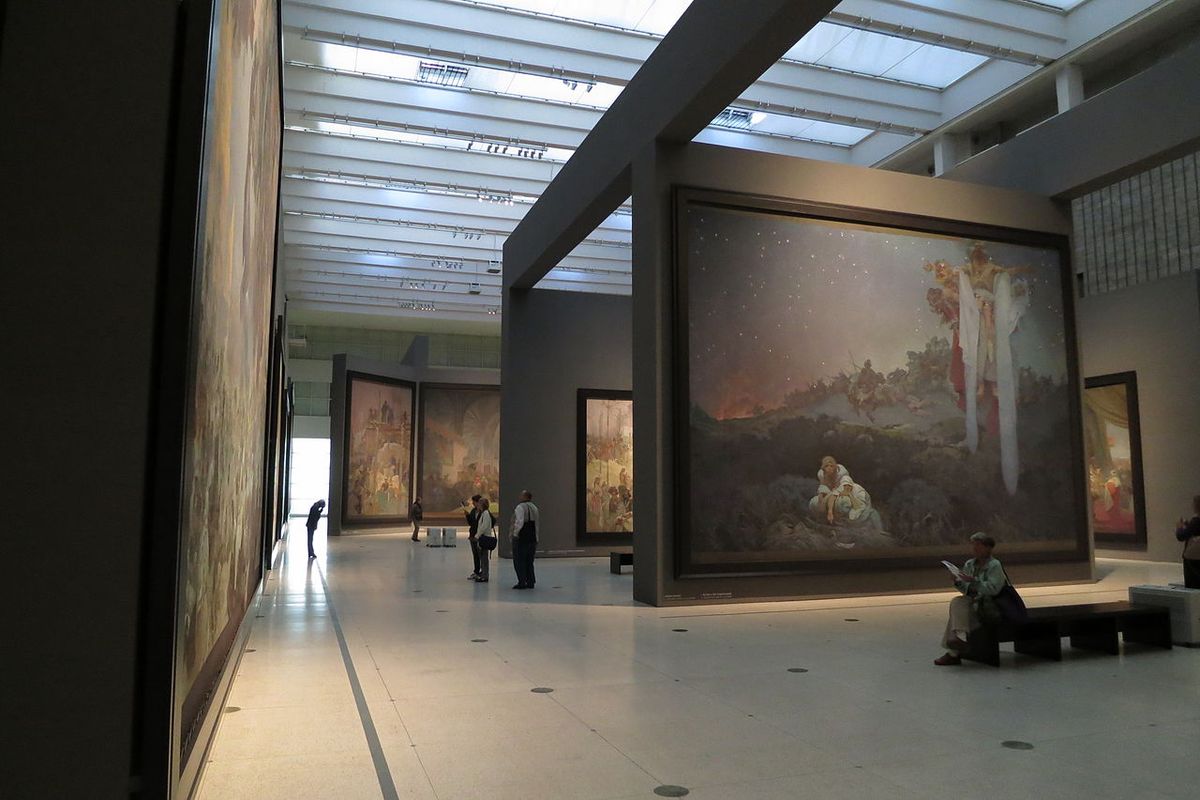
August 25, 2020
Elena Martinique
In a stunning series of twenty monumental canvases, the renowned Art Nouveau Czech artist Alphonse Mucha sought to depict the history of the Slav people and civilization. Titled The Slav Epic, the series was conceived as a monument for all the Slavonic peoples, to which the artist devoted the latter half of his artistic career.
The The Slav Epic series was conceived on a noble idea - Mucha wanted to unite all the Slavs through their common history and their mutual reverence for peace and learning, eventually inspiring them to work for humanity using their experience and virtue. The complete series of these immense paintings was officially presented to the City of Prague as a gift in 1928, coinciding with the 10th Anniversary of the nation's independence.
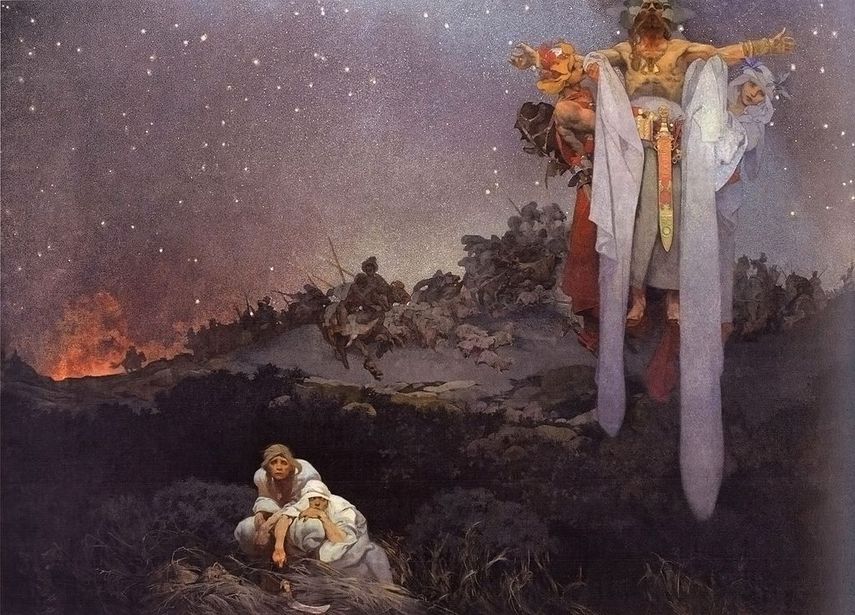
Alphonse Mucha - Slavs in their Original Homeland, 1912. Tempera and oil on canvas, 610 x 810 cm. Mucha Museum Prague
The Inception of the Series
Among the most famous Czech visual artists, Alphonse Mucha began his career by painting mostly theatrical scenery in his native Moravia, a historical region in the east of the Czech Republic. After successfully completing a commission by Count Karl Khuen of Mikulov to paint Hrusovany Emmahof Castle with sceneries, the Count sponsored the artist's training at the Munich Academy of Fine Arts. Following his studies, the Czech moved to Paris and began producing advertising demonstrations and designs, for theatre sets, characterized by faded pastel colors and featuring sensual, graceful, and delicate young women in neoclassical robes, enclosed by profuse flowers. Initially called the Mucha style, it later became known as Art Nouveau, a movement that opened a new chapter in art. However, Mucha, who was a great patriot, would refer to his artistic style not as Art Nouveau, but as uniquely “Slavonic".
The artist first came to the idea for the Slav Epic while working on the design for the inside of the Pavilion of Bosnia-Herzegovina commissioned by the Austro-Hungarian government for the Paris Exhibition of 1900. During the preparations for the project, he travelled through the Balkans, getting acquainted with the region's history and customs. The artist recalled:
It was midnight, and there I was all alone in my studio in the rue du Val-de-Grâce among my pictures, posters and panels. I became very excited. I saw my work adorning the salons of the highest society or flattering people of the great world with smiling and ennobled portraits. [...] And in my spirit I saw myself sinfully misappropriating what belonged to my people. It was midnight and, as I stood there looking at all these things, I swore a solemn promise that the remainder of my life would be filled exclusively with work for the nation.
Inspired by this experience, Mucha deciding to illustrate the "joy and sorrows" of his own community and of all the other Slavs, going on to find a contributor who would support his project. After several trips to the United States, it wasn't until 1909 that he managed to obtain grants by an American philanthropist and keen admirer of the Slavic culture, Charles Richard Crane.
His preparation began with traveling through Russia, Poland and the Balkans and consulting historians regarding details of historical events he wanted to depict. Working from an apartment and a studio in Zbiroh Castle in Bohemia, it took another 18 years to complete the whole series.

The Inception of the Series
Among the most famous Czech visual artists, Alphonse Mucha began his career by painting mostly theatrical scenery in his native Moravia, a historical region in the east of the Czech Republic. After successfully completing a commission by Count Karl Khuen of Mikulov to paint Hrusovany Emmahof Castle with sceneries, the Count sponsored the artist's training at the Munich Academy of Fine Arts. Following his studies, the Czech moved to Paris and began producing advertising demonstrations and designs, for theatre sets, characterized by faded pastel colors and featuring sensual, graceful, and delicate young women in neoclassical robes, enclosed by profuse flowers. Initially called the Mucha style, it later became known as Art Nouveau, a movement that opened a new chapter in art. However, Mucha, who was a great patriot, would refer to his artistic style not as Art Nouveau, but as uniquely “Slavonic".
The artist first came to the idea for the Slav Epic while working on the design for the inside of the Pavilion of Bosnia-Herzegovina commissioned by the Austro-Hungarian government for the Paris Exhibition of 1900. During the preparations for the project, he travelled through the Balkans, getting acquainted with the region's history and customs. The artist recalled:
It was midnight, and there I was all alone in my studio in the rue du Val-de-Grâce among my pictures, posters and panels. I became very excited. I saw my work adorning the salons of the highest society or flattering people of the great world with smiling and ennobled portraits. [...] And in my spirit I saw myself sinfully misappropriating what belonged to my people. It was midnight and, as I stood there looking at all these things, I swore a solemn promise that the remainder of my life would be filled exclusively with work for the nation.
Inspired by this experience, Mucha deciding to illustrate the "joy and sorrows" of his own community and of all the other Slavs, going on to find a contributor who would support his project. After several trips to the United States, it wasn't until 1909 that he managed to obtain grants by an American philanthropist and keen admirer of the Slavic culture, Charles Richard Crane.
His preparation began with traveling through Russia, Poland and the Balkans and consulting historians regarding details of historical events he wanted to depict. Working from an apartment and a studio in Zbiroh Castle in Bohemia, it took another 18 years to complete the whole series.

Alphonse Mucha - The Celebration of Svantovit, 1912. Oil on canvas, 610 x 810 cm. Collection of Prague City Gallery
The Slav Epic Paintings
The Slav Epic depicts twenty major episodes from the Slavic past, old to new, ten episodes from Czech history and ten others on historical episodes from more Slavonic areas.
Mucha's first canvas in the The Slav Epic series was The Slavs in Their Original Homeland, completed in 1912, focusing on the trials of the Slav tribes in the sixth century, when the lands where they were settling were contested by Germanic tribes on the one hand, and the Byzantine empire. The final canvas, The Apotheosis of the Slavs celebrates the triumphant victory of all the Slavs whose homelands in 1918 finally became their very own.
In 1918, Mucha exhibited the first eleven canvases of The Slav Epic in the Prague's Clementinum. In his opening speech, he stated:
The mission of the Epic is not completed. Let it announce to foreign friends – and even to enemies – who we were, who we are, and what we hope for. May the strength of the Slav spirit command their respect, because from respect, love is born.
A collective representation of moments in the history of the Slavs, The Slav Epic conveys Pan-Slavic ideals in visual format, linking different Slavic nations by emphasizing their shared historical and cultural traits. Throughout the series, Mucha employed different compositions of color, symbols and figures to present ideas, hidden messages and various phenomena. While some aspects have clear links to particular historic events, some are down to the interpretation of the viewer solely. Breathtakingly large, some of the works measure up to six meters tall and eight meters wide. Each work has a title and a subtitle that explains the importance of the specific scene for Slavic history.
Putting much thought into his style as much as the subject, Mucha focused on conveying the emotions of the scenes through skillful drawings rather than previously established national styles. He combined a custom tempera paint for his large canvases, and oil paint for select details, achieving a luminous effect that he deemed necessary for the mythological tableaux he was creating.
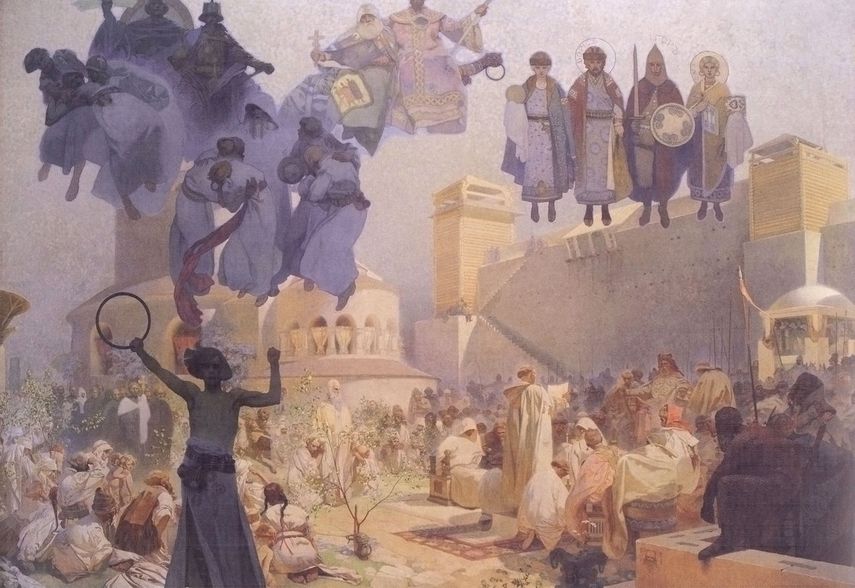
The Slav Epic Paintings
The Slav Epic depicts twenty major episodes from the Slavic past, old to new, ten episodes from Czech history and ten others on historical episodes from more Slavonic areas.
Mucha's first canvas in the The Slav Epic series was The Slavs in Their Original Homeland, completed in 1912, focusing on the trials of the Slav tribes in the sixth century, when the lands where they were settling were contested by Germanic tribes on the one hand, and the Byzantine empire. The final canvas, The Apotheosis of the Slavs celebrates the triumphant victory of all the Slavs whose homelands in 1918 finally became their very own.
In 1918, Mucha exhibited the first eleven canvases of The Slav Epic in the Prague's Clementinum. In his opening speech, he stated:
The mission of the Epic is not completed. Let it announce to foreign friends – and even to enemies – who we were, who we are, and what we hope for. May the strength of the Slav spirit command their respect, because from respect, love is born.
A collective representation of moments in the history of the Slavs, The Slav Epic conveys Pan-Slavic ideals in visual format, linking different Slavic nations by emphasizing their shared historical and cultural traits. Throughout the series, Mucha employed different compositions of color, symbols and figures to present ideas, hidden messages and various phenomena. While some aspects have clear links to particular historic events, some are down to the interpretation of the viewer solely. Breathtakingly large, some of the works measure up to six meters tall and eight meters wide. Each work has a title and a subtitle that explains the importance of the specific scene for Slavic history.
Putting much thought into his style as much as the subject, Mucha focused on conveying the emotions of the scenes through skillful drawings rather than previously established national styles. He combined a custom tempera paint for his large canvases, and oil paint for select details, achieving a luminous effect that he deemed necessary for the mythological tableaux he was creating.

Alphonse Mucha - The Introduction of the Slavonic Liturgy, 1912. Tempera on canvas, 610 x 810 cm. Mucha Museum Prague
The Controversies Around the Display of the Works
The complete Slav Epic series was first exhibited in 1928 in the Trade Fair Palace in Prague to great critical acclaim. The artist decided to donate the works to the City of Prague, provided that the city builds an exhibition pavilion for it. However, the pavilion hasn't been built to this day.
Before his death in 1939, Much was interrogated by the Gestapo as an important exponent of public life in Czechoslovakia, and as the war began raging, the The Slav Epic was wrapped and hidden away to prevent seizure by the Nazis.
After the war, the paintings were moved to the chateau at Moravský Krumlov by a group of local patriots, and the cycle went on display there in 1963. Much consideration has been given to relocating the series from Moravský Krumlov to Prague, resulting in a decade-long legal battle that intensified in early 2010. After being blocked by the Mucha Foundation to have the works for restoration, the City of Prague argued that not Alphonse Mucha but Charles R. Crane was the owner of the paintings and that he has donated the series to the city. On the other hand, John Mucha, who runs the Foundation, claimed that Prague never became the owner of the series because it did not meet the artist’s condition of building an exhibition hall for the works.
After years of negotiations, in 2019, the Prague City Council decided that The Slav Epic will be exhibited at Moravsky Krumlov chateau for at least five years until Prague will have a suitable venue for the monumental works of art.
[UPDATE January 25, 2021] According to a new report from the Art Newspaper, Slav Epic has finally found a home. It will be displayed in whole in a to-be-constructed development designed by Thomas Heatherwick located in Prague, and the facility will open in 2026.

Alphonse Mucha - The Oath of Omladina Under the Slavic Linden Tree, 1926. Egg tempera and oil on canvas, 390 x 590 cm. Prague City Gallery
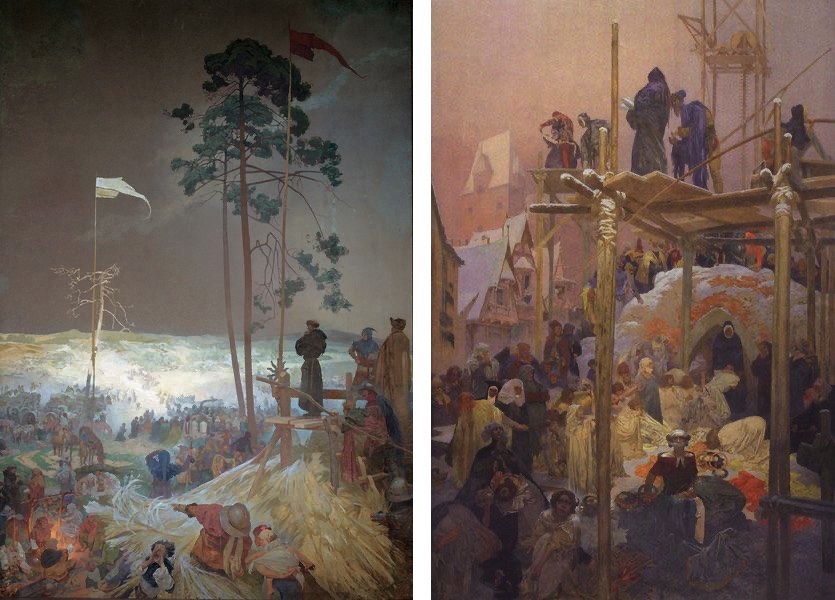
The Controversies Around the Display of the Works
The complete Slav Epic series was first exhibited in 1928 in the Trade Fair Palace in Prague to great critical acclaim. The artist decided to donate the works to the City of Prague, provided that the city builds an exhibition pavilion for it. However, the pavilion hasn't been built to this day.
Before his death in 1939, Much was interrogated by the Gestapo as an important exponent of public life in Czechoslovakia, and as the war began raging, the The Slav Epic was wrapped and hidden away to prevent seizure by the Nazis.
After the war, the paintings were moved to the chateau at Moravský Krumlov by a group of local patriots, and the cycle went on display there in 1963. Much consideration has been given to relocating the series from Moravský Krumlov to Prague, resulting in a decade-long legal battle that intensified in early 2010. After being blocked by the Mucha Foundation to have the works for restoration, the City of Prague argued that not Alphonse Mucha but Charles R. Crane was the owner of the paintings and that he has donated the series to the city. On the other hand, John Mucha, who runs the Foundation, claimed that Prague never became the owner of the series because it did not meet the artist’s condition of building an exhibition hall for the works.
After years of negotiations, in 2019, the Prague City Council decided that The Slav Epic will be exhibited at Moravsky Krumlov chateau for at least five years until Prague will have a suitable venue for the monumental works of art.
[UPDATE January 25, 2021] According to a new report from the Art Newspaper, Slav Epic has finally found a home. It will be displayed in whole in a to-be-constructed development designed by Thomas Heatherwick located in Prague, and the facility will open in 2026.

Alphonse Mucha - The Oath of Omladina Under the Slavic Linden Tree, 1926. Egg tempera and oil on canvas, 390 x 590 cm. Prague City Gallery

Left: Alphonse Mucha - The Meeting at Křížky, 1916. Egg tempera and oil on canvas, 620 x 405 cm / Right: Alphonse Mucha - Jan Milíč Kroměříž, 1916. Oil on canvas, 620 x 405 cm. Prague City Gallery


Alphonse Mucha - The Coronation of the Serbian Tsar Stefan Dušan as East Roman Emperor, 1926. Oil on canvas, 480 x 405 cm. Prague City Gallery
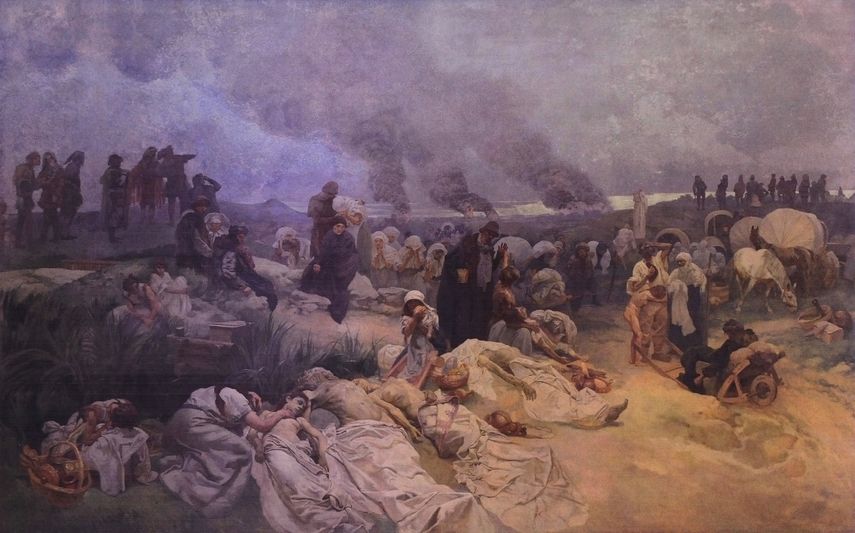

Alphonse Mucha - Petr Chelčický at Vodňany, 1918.
Editors’ Tip: Alphonse Mucha: Masterworks
Though very much an individual and spiritual artist, Alfonse Mucha was a defining figure of the Art Nouveau era and is loved for his distinctive lush style and images of beautiful women in arabesque poses among the plethora of paintings, posters, advertisements and designs he produced. Admire a whole range of his work here in its full glory with succinct accompanying text.
Featured image: Alphonse Mucha's The Slav Epic in the National Gallery of Prague. All images Creative Commons.
Though very much an individual and spiritual artist, Alfonse Mucha was a defining figure of the Art Nouveau era and is loved for his distinctive lush style and images of beautiful women in arabesque poses among the plethora of paintings, posters, advertisements and designs he produced. Admire a whole range of his work here in its full glory with succinct accompanying text.
Featured image: Alphonse Mucha's The Slav Epic in the National Gallery of Prague. All images Creative Commons.


No comments:
Post a Comment